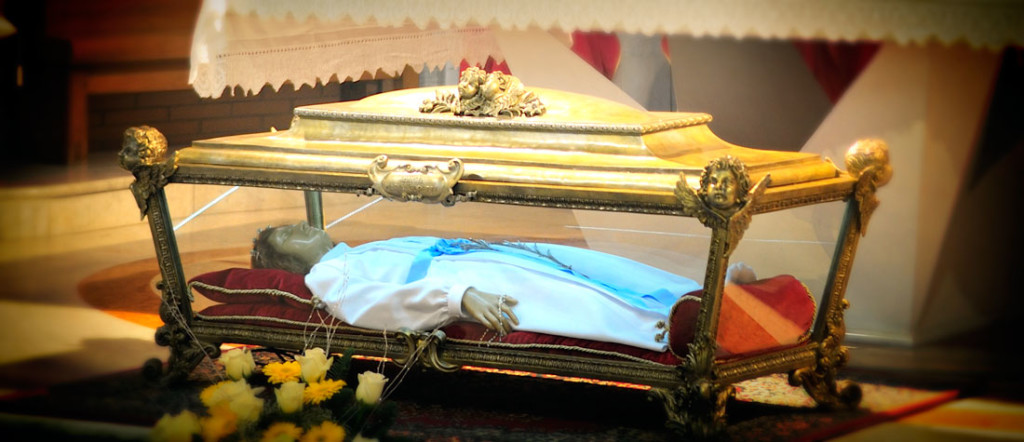November 1, 2015
As many of you know, the major relics of St. Maria Goretti are currently on tour through the United States. Today–on All Saints’ Day, of all days–they are here in my hometown of Baton Rouge. The glass reliquary edged with gold holds a wax statue of the church’s youngest canonized saint. Inside the statue is her skeleton, minus her right arm, which was donated to the church in her birth town of Corinaldo, Italy that now bears her name, and some small flakes of bone that have been removed for placement in altars and for use in the church’s ministry. Such are the facts; you can read them on the tour’s website. What the website does not tell you is that inside that glass box lies the body of my sister.
By the laws of biology, I do not have any sisters, only one brother. He is as good a brother as anyone could ask for, but growing up, I could not help but feel that there was something missing from my life. When I saw other girls interacting with their sisters–even when they were fighting, as sisters often do–I could not help but feel lonely.
When I was sixteen and the time came to choose a saint as my patron for confirmation, a story that I had heard somewhere called out to me from the murky depths of half-remembered thoughts. A young girl who had chosen to be murdered rather than surrender her virginity… As a sixteen-year-old just getting my feet wet in the bewildering world of courtship, it was a story that spoke volumes to me. Here was someone who could guide me, someone neither too old nor too far removed by centuries to be relatable. I told what I remembered of the story to my priest and asked, “Do you know which saint that was?”
“Maria Goretti.”
“No, I don’t think that was it.” The name did not sound even slightly familiar. To this day, I cannot make her name connect to that first half-memory of her tale. Maybe whoever told it to me never said her name. Maybe whoever-it-was got her mixed up with someone else. Maybe it was Maria herself who whispered the story to me through my dreams. But eventually, after asking around and consistently receiving the same answer, I accepted that the story could only be connected to one person. Then I asked St. Maria Goretti not only to become my patron through confirmation; I asked her to become my sister.
On the day when the bishop laid his hands on my head and said, “Maria Goretti, receive the Holy Spirit,” the Spirit rushed upon me, and my sister held my hand. There are several moments missing from my memory of that day, not because I have forgotten them but because I did not witness them in any earthly sense. I never could remember walking back to my pew. Nor could I figure out how I had gotten there, because I could not feel my legs. The ability to consciously control my body seemed utterly gone. Yet my body did what it needed to do. No one but me ever noticed that I was not genuinely present in that church. Where I was, I cannot tell you because it was not a “where.” I was with the Spirit, and it was my sister who led me there.
Since that day, Maria Goretti has been as much a sister to me as if we had been born to the same parents. She never fails to answer my late-night “phone calls.” She hugs me both in sadness and in joy. She does not get mad at me when I am two or three days late to remember her feast day, as I usually am. She smiles tolerantly and shrugs. For many years, I used to wear her medal every day. I suspect that my thesis professor from my MFA still remembers me as The Girl with the Medal of St. Maria Goretti; he had never met anyone who wore such a token before. But I never did any research about my sister’s life beyond learning a few superficial facts. On the one hand, it felt unnecessary. Who researches her own sister? It did not feel like a proper way to get to know someone. On the other hand, I think I have always been afraid that what I would learn about the “real” Maria Goretti would not fit with my experience of the one I call my sister. I think I was afraid to discover that our friendship was all a product of my own imagination.
I finally faced that fear last night when I went to view her relics at Our Lady of Mercy Church. When I first arrived, I was indignant at the lights that seemed to turn the church into a stadium, an effect made worse by the din of chatter from the pilgrims and the table in the vestibule arrayed with “spiritual” wares for sale. I had not come to view some gaudy, theatrical show led by the dead on Halloween. I had come to visit my sister–or rather, she had come to visit me. But once Maria reminded me that the noise and lights and salesmanship were inevitable foibles common to every human crowd, I got in line and took my allotted fifteen seconds kneeling by her side. I forgot to bring a handkerchief: a stroke of idiocy, given my personal history with spiritual experiences. There is now a shirt in my laundry hamper that desperately needs to be washed. But I remembered to bring the medal, which I touched to the glass and then returned to its place around my neck. I slinked into a pew and, through my tears, began to pray my rosary. I made it only to the second joyful mystery, the Visitation–the greeting of one holy woman by another, her kinswoman–before the church bells tolled and a man stepped up to the ambo to lead the hourly Chaplet of Divine Mercy.
It is probably for the best that I forgot my handkerchief; otherwise, I might have sat in that pew and prayed all night. Instead, I finished the Chaplet, then crossed the street to the parish hall to find a bathroom and a paper towel. The parish hall was also the temporary home of the St. Maria Goretti Museum, where I sat down and (finally) learned more about her life from a film.
Everything I have discovered about St. Maria Goretti through our mutual prayers is true. The historical figure I met at the museum was no one else but the sister I have loved for twenty years. On the drive home, I was continually tempted to try to find some moral in her coming, something that she was calling me to change. Continually, she stopped me. “I came because I love you,” she said. “What other reason do I need?”
Maria Goretti’s relics will be gone from Baton Rouge by the time you read this. Just as any relative from out of town comes to see all those she loves, Maria has a special kiss to bestow on all the thousands who are flocking to her relics’ tour. I know she must move on to see her other brothers and sisters, too. But I also know that someday it will be my turn to go to her, to finally meet my sister face to face in the place that we will both call home. Until then, she will always be here to hold my hand and lead me toward the Spirit.
Let her do the same for you.
Karen Ullo is the author of Jennifer the Damned, now available from Wiseblood Books. To find out more, go to www.karenullo.com.


Lovely!